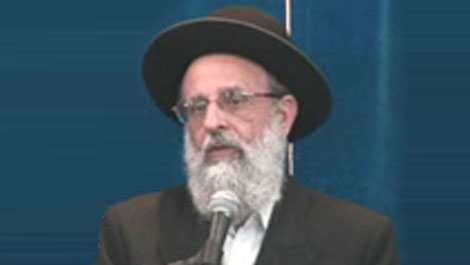Beit Midrash
- Library-Sifria
- Pninei Halacha
- Pesach
1.Matza Ashira ("Egg Matza")
The ĥametz that the Torah forbids is comprised of flour and water. If flour was kneaded with fruit juice – even if the dough sits a full day and rises – it is not considered ĥametz since rising of this kind is different from the type forbidden by the Torah. The category of "fruit juice" ("mei peirot") includes wine, honey, milk, oil, and egg, in addition to all juices squeezed from a fruit, like apple or berry juice. Since fruit juice does not cause dough to become ĥametz, one may knead, bake, and eat such dough on Pesaĥ. Nevertheless, one would not fulfill the mitzva of matza on the first night of Pesaĥ with it, because the Torah calls matza "leĥem oni" ("poor man’s bread"), and matza made from fruit juice is "matza ashira" ("rich matza" – colloquially known in English as "egg matza"), since it possesses more than the taste of just flour and water.
If a drop of water gets mixed in with the fruit juice, it can cause the dough to become ĥametz. Moreover, according to many poskim, the combination of water and fruit juice actually expedites the leavening process. Thus, in order to avoid such doubts, the Sages prohibited kneading dough with a mixture of fruit juice and water during Pesaĥ (SA 462:1-3).
The Ashkenazic custom is to avoid eating anything made of dough kneaded with fruit juice out of concern that water mixed with the fruit juice causing the dough to become ĥametz. Furthermore, it takes into account the opinion of Rashi, who disagrees with most Rishonim and maintains that fruit juice alone can cause something to become ĥametz on the rabbinic level. Although in principle it is possible to follow the lenient ruling of the vast majority of poskim, Ashkenazic custom, which should not be altered, is nevertheless strict, except in the case of the elderly and ill, where the custom is to be lenient (Rema 462:4). Nowadays, many Sephardic poskim also rule stringently, because it is known that water and other ingredients are generally added to fruit juice, increasing the likelihood that the egg matza became ĥametz (R. Mordechai Eliyahu). 1
2.Becoming Ĥametz Once It Has Been Baked, and the Status of Matza Sheruya (Soaked Matza; "Gebrokts")
Once matza has been completely baked, the flour in it loses the capacity to become ĥametz, even if it is soaked in water for a long time. An indication that the matza is fully baked is that a crust has formed on its surface and that it breaks cleanly, with no threads of unbaked dough extending from it. Thus, it is permitted to soak matza in soup, and an elderly or sick person who cannot eat dry matza on the Seder night may soften matza by soaking it in water (SA 461:4 and below 16:29). Likewise, if the matza was ground into flour, it is permitted to knead it with water; one need not worry about it becoming ĥametz because, as mentioned, once it has been thoroughly baked, it cannot (SA 463:3). Therefore, one may bake cakes from the five species of grain during Pesaĥ, or cook various dishes – such as gefilte fish and matza balls – that contain matza meal.
Yet there are some who avoid soaking fully-baked matza in water, lest some of the flour was not kneaded properly and remained unbaked, and soaking the matza will cause the unbaked dough to become ĥametz. They likewise fear that some flour may have stuck to the matza after the baking process, and if the matza is soaked in water, this flour will become ĥametz. There is yet another reason to be strict about matza meal: an unlearned person might confuse matza meal with real flour and end up violating the prohibition of ĥametz on Pesaĥ. Ĥasidim accept this stringency and refrain from eating matza that has been soaked, or "gebrokts."
The poskim, however, nearly unanimously agree that one need not be stringent, since it can be assumed that the kneading was thorough, leaving no flour unkneaded or unbaked. This is the custom of Sephardic and non-Ĥasidic Ashkenazic Jews. Today, even some Ĥasidic Jews are lenient because, due to the popular practice of baking thin matzot, there is no longer any concern that some of the flour was not properly baked. Likewise, there is no concern that flour may have gotten stuck to the matza, since matza bakeries are careful to separate the area where flour is handled from the area where the matza comes out of the oven. MB 458:4 states: "Although in principle there is no reason for concern about this, and it is permitted to eat soaked matza, one should not mock conscientious people who choose to be stringent." 2
^ 1.. There are two issues here: The first is whether flour mixed with fruit juice can become ĥametz, and the second is whether, in a case where water was added to the dough, one may knead the dough while being careful that it does not become ĥametz.
The first issue is summarized in Birur Halakha on Pesaĥim 35a, s.v. "mei peirot ein maĥmitzin." According to Rashi and those who agree with him, a flour and fruit juice mixture can become ĥametz nuksheh (see above 2:5), which is rabbinically forbidden. Conversely, most Rishonim maintain that flour mixed with fruit juice alone never becomes ĥametz, but if any water got into the mixture, the mixture can become ĥametz. There is a dispute about the severity of this ĥametz: According to Rambam, it is ĥametz gamur, and according to Rabbeinu Tam it is ĥametz nuksheh. Pri Megadim states that all agree it becomes ĥametz gamur when the majority of liquid in the mixture is water (BHL 462:2 s.v. "memaharim"). See the book Matza Ashira 5:7-8.
The second issue is explained in Birur Halakha on Pesaĥim 36a, which cites a tannaitic dispute about matza ashira on Pesaĥ. According to Rif and Rambam, the halakha follows Rabbi Akiva that one is permitted to knead flour in a mix of fruit juice and water provided that one takes caution to prevent the mixture from becoming ĥametz, just as one would with a standard flour-water mixture. This is also the opinion of R. Natronai Gaon and Me’iri. On the other hand, many Rishonim maintain that one should not knead flour with fruit juice and water, since it turns into ĥametz faster than does flour and water. There is a dispute about what to do be-di’avad. According to R. Hai Gaon and Behag, the halakha follows Rabban Gamliel that one is required to burn the kneaded dough. According to Rabbeinu Ĥananel, Ritz Gi’at, and Rosh, the halakha follows the Sages that if one bakes the dough very quickly, he is permitted to eat it. This is the opinion that SA accepts (462:2). The Ashkenazic custom is to be strict out of concern for Rashi’s opinion that flour and fruit juice alone can become ĥametz, or out of concern that some water will mix with the fruit juice.
The parameters of what is considered water and what is considered fruit juice are discussed in SA 462:3 and 7 and §466. The entire topic is summarized in detail in Encyclopedia Talmudit entry "Ĥametz" pp. 89-99.
Regarding the Sephardic custom, R. Mordechai Eliyahu had a long-standing opposition to certifying matza ashira as kosher for Pesaĥ out of concern that the fruit juice has been mixed with water or a leavening agent. (There are also grounds to forbid this because it generates activity that mimics the process of becoming ĥametz, as explained by Maharam Halawa on Pesaĥim 28a and Matza Ashira p. 178.) Over time, it became apparent that this concern was justified, and water and occasionally leavening agents are added to fruit juice. Nevertheless, some authorities rule leniently; according to them, these leavening agents do not cause the dough to become ĥametz. This ruling appears in Yabi’a Omer 9:42 and Shema Shlomo 4:13-17. However, according to many authorities these leavening agents are forbidden by the Torah, or at least rabbinically, and therefore they prohibit Sephardim from eating factory-produced matza ashira on Pesaĥ.
^ 2.. Pesaĥim 39b states: "These are the things that cannot become ĥametz: baked items…." Rambam rules accordingly in MT, Laws of Ĥametz and Matza 5:5, and this is the consensus of the Rishonim. The sign that something is completely baked is that it has a crust on the outside and that it breaks cleanly, with no threads of dough extending (these two standards are identical, as per MB 461:15 and SHT 23 ad loc.). SAH 463:3 states that a baked item cannot become ĥametz and one may cook with matza meal. However, responsum §6 at the end of SAH states that matza meal is only permissible if one is absolutely certain that all of the flour was fully baked, and one should be concerned that perhaps not all of the flour was fully baked or that some flour stuck to the matzot after baking. SAH concludes that one should not reprimand the masses who are lenient since they have acceptable authorities on which to rely, but one who is stringent is commendable. Regarding matza meal, Knesset Ha-gedola §461 recounts that a woman once saw her neighbor, the rabbi’s wife, cooking and frying with matza meal and mistakenly assumed that it was permissible to use actual flour on Pesaĥ. When the town’s rabbis heard what had happened, they banned matza meal because of marit ayin (see Tur §463). Pri Ĥadash and many other Aĥaronim disagreed with this ban; see also She’elat Yaavetz 2:65 citing the author’s father (Ĥakham Zvi) and Sha’arei Teshuva §460, cited in MB 458:4. In Ma’aseh Rav §183 it is written that one is permitted to make kufta'ot (dumplings). See Encyclopedia Talmudit entry "Ĥametz" pp. 83-84. Kaf Ha-ĥayim 461:31 mentions the different opinions of the Aĥaronim, and concludes: "Where the custom is to be lenient, one may be lenient, since there is basis for this opinion, but where there is no custom, one should be stringent." It adds: "There is no concern about rekikim ("flatbreads")." Our matzot are "rekikim." Yeĥaveh Da’at 1:21 rules leniently le-khatĥila and states that one who was stringent because he thought that this is the halakha erred and may switch to the lenient practice without performing hatarat nedarim (the annulment of vows). However, one who accepted the stringency (without saying "bli neder") because he wanted to go beyond the letter of the law and now wishes to be lenient should first perform hatarat nedarim.
In practice, many people of Ĥasidic descent no longer observe the stringency of gebrokts. This is because contemporary matzot are very thin and our ovens are very strong. If one’s father was lenient in this matter, one need not perform hatarat nedarim, even if he is from a Ĥasidic family. However, if one’s father was stringent and he wants to be lenient, he should perform hatarat nedarim and make sure not to insult his father.
The details of practicing the stringency of gebrokts: Those who do not eat gebrokts may be lenient when it comes to children or sick people, since soaking matza is not considered making ĥametz on Pesaĥ. Additionally, Jews in the Diaspora who keep gebrokts customarily make matza balls on the eighth day of Pesaĥ to show that matza sheruya is not fully prohibited. They prepare the matza balls on Ĥol Ha-mo’ed but do not otherwise eat off the dishes used to prepare the gebrokts. She’arim Metzuyanim Be-halakha 113:7 allows using utensils in which matza was soaked. On the other hand, Responsa Kinyan Torah 2:87 states that one may not even soak matza for children or sick people.
As far as soaking the matza in fruit juice, SAH (op cit.) states that one need not be stringent, and indeed the widespread custom is to soak matza in wine and spread various spreads on matza. Kinyan Torah 2:87 is stringent regarding this as well. See the extended discussion in Piskei Teshuvot 458:5-7.
Sha’arei Teshuva 460:10 states that even according to those who keep gebrokts one may dip the matza in water and eat it immediately, before it could conceivably become ĥametz. Those who are stringent about dipping matza in fruit juice are stringent about this as well.























